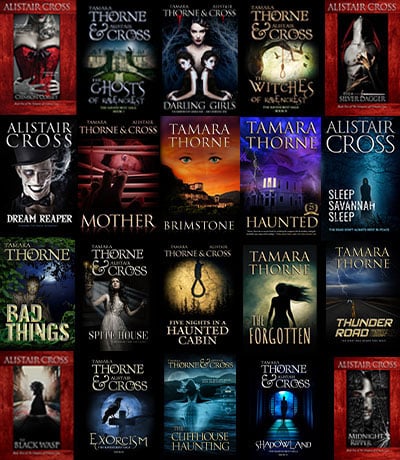Extreme Collaborating
By Thorne & Cross
Home > The Hallway > Extreme Collaborating

A radio interviewer asked us how we write together, and that was one of the most eye-opening questions we’ve ever had. She was amazed when we told her our method and said she’d never heard of anyone writing like that before.
Evidently, many writers split things up with one brainstorming and the other writing. Neither of us can even imagine having any fun doing our job this way. To not be allowed to brainstorm would be horrible! And to not write would be just as bad! We can each imagine this working in non-fiction, but in fiction, if you don’t love both sides – creating and writing – where does that leave you? How can you imagine ideas for your plot and characters without being able to set them down as well, and vice versa? Can a good writer write without his or her imagination taking off and soaring to the heavens? It sounds absolutely horrible to us.
Our collaborations are a 50/50 effort. We plot together, we develop characters together, and we even transcribe together by getting on Skype, opening the Cloud, and working side by side. Sometimes Tamara takes the lead, sometimes Alistair does – but nothing is written without both of us present. We each have our own individual strengths and weaknesses, and we each are aware of the other’s. Luckily for us – as we learned early on – our weaknesses and strengths balance out; where one of us has difficulty, the other is at ease.
One very important part of our process that we stress very much when asked about it is the personal side of our relationship. Writing is a job, a business, and although we are business partners, we are also friends. We may share the same vision, the same sensibilities, and even similar writing styles, but all of this is pointless without three very important elements: respect, honesty, and loyalty.
Respect comes first. We are aware of each other’s time. We meet every day, six days a week, and work anywhere from 8 to 10 hours. But if something comes up or one of us is running late, we are okay with that.
As for honesty… honesty is something you have to be comfortable with if you intend to write with another person. If one of us hates what the other is writing – though it hasn’t really happened – we’d say so… but kindly. If one of us isn’t feeling the same vibe as the other and thinks the story needs to go a different direction, we discuss it openly.
No drama. We are similar in that we both avoid drama – and the people who spew it – so one of us getting drawn into the chaos of the other one’s personal life issues is never a problem for us. This zero tolerance for drama, in fact, is probably the glue that holds this whole thing together (sure, we each tell the other what’s going on in our lives – we’re friends and that’s what friends do – but we don’t dwell. We go to work).
So, kindness, honesty, and a no drama policy are what makes up the respect facet of this deal. Then there is loyalty.
Loyalty comes into play because we are given a lot of advice by outside forces, and sometimes, the advice is not good. We’ve made a firm pact that no decisions will be made without the consent of the other one. No one is allowed to call one of us and discuss changes behind the other’s back. We are business partners, and we operate as such, no exceptions.
With loyalty comes trust, which could easily be the fourth part of the sum. We trust each other with the characters, the storyline, and on a personal level as well, but this trust is built on the foundation of the respect, honesty, and loyalty to which we adhere.

And now that the personal elements of our collaboration have been covered, we come to the creative part of the process.
Each day we spend an hour or two in the morning warming up. We chat, we do our PR and marketing work, whether it’s writing a blog, posting to Facebook, or answering interview questions. We spend a little time studying some aspect of our business most mornings as well, whether that’s going through a lot of covers or promotional posters and talking about what we like and dislike, discussing articles we’ve just read on traditional vs indie publishing, or anything else writing-oriented. We tell some jokes. We laugh a lot.
And then we get down to writing. If we’re having trouble getting going, we get silly, each sneaking in outrageous dialogue or descriptions for the other to laugh at. That’s actually one of the best tricks we’ve found for getting a scene moving. We’ll add on to the silliness, each of us, and suddenly the scene comes to life and, when we’re done, we remove the goofy stuff.
We each enjoy following certain characters and take the lead on our favorites, but we are also careful to switch off so that we each know every character well. To us, familiarity with our characters – all of them – is vital to the story.
While, individually, we both do a lot of world-building in order to get to know our characters and their locale, together, we probably spend twice as much time doing this. When you are collaborating, the littlest details become important and are (usually) best figured out beforehand because both of us must know whether a character has dimples or drives a beat-up old Chevy or hates seafood. Otherwise, incongruities can get past us, unnoticed.
The characters’ voices, however, evolve during writing and whoever creates the voice sets the tone the other follows for that character. For example, a character in one of our upcoming novels has a unique way of swearing that Alistair made up. We both love voicing her and work together to get the most insane profanities out of her as we write, always following Alistair’s original style.
While we occasionally write two scenes in tandem – this usually happens when we are writing one scene together and one of us is inspired by something the other writes – we still consider ourselves to be writing together; after all, via Skype, we have instant access to one another. After that, we go over both scenes together and make sure everything is in sync and do a light edit. Mostly, though, we quite literally write together. One of us may write most of a scene with the other trailing along fixing things, or simply taking in the tale as it evolves. Sometimes we take turns in the same scene. Tamara often takes over descriptions of locale because she really enjoys it. Alistair enjoys writing certain situations and takes those. We think the main reason one or the other of us takes the lead, though, is character. We each have our favorites.
We write in similar voices and have similar sensibilities, senses of humor, likes and dislikes, and this, of course, is part of our chemistry. But if you have a collaborator that you constantly disagree with, our question is why? If you have nothing in common, how can you enjoy your work – or one another?
We received some great feedback the other day. After reading The New Governess, the first installment of our serialized novel, The Ghosts of Ravencrest, a reader said to us: “Which one of you wrote this? I can’t tell.” To which we happily answered, “We both wrote it.” And we did. Just like we wrote this blog. Together, in the Cloud.
